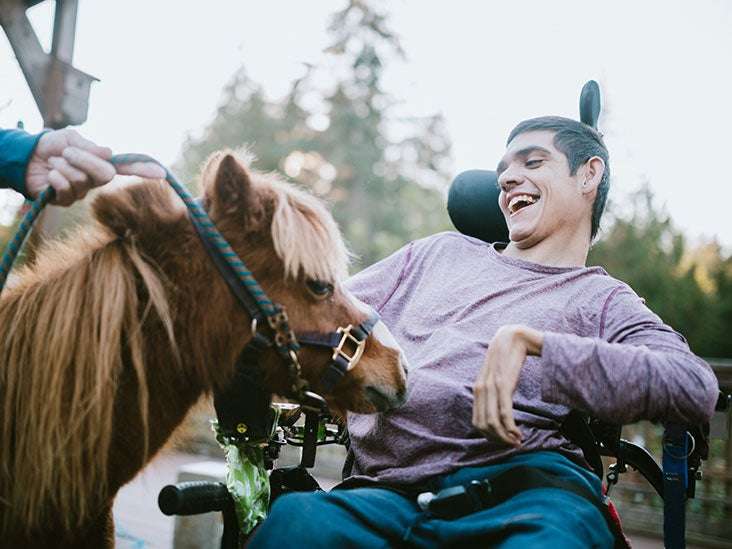NOV.
23,
2016
I remember when I was seven, my Great-Uncle Benji said to my parents, “Allison needs a dog.” It was at that time, my life changed. I was a very quiet, reserved kid, but dogs brought me out of my shell. They were with me during good times, painful times and major life events—and loved me no matter how I reacted to these situations. They remained stable forces in my life, even during the darkest turmoil.
Nowadays, I work with clients who live with depression, anxiety and addictions, and they don’t always feel like there is hope. It’s hard for them to see light in the midst of their darkness, and peace seems so far away. But when I use my dogs during pet therapy visits, I see how animals brighten up a person’s mood, even if it’s for a short time. That moment allows a small trickle of light into that person’s heart, which may not have been there before.
During one session in particular, a client asked if she could get on the floor because she wanted to talk to my therapy dog about something “very important.” She buried her head into my dog’s fur and talked about the horrible week she had endured. Stroking my dog’s fur, my client was overcome with a sense of calm in a way I could not have accomplished by merely talking with her. No judgments, no expectations—just a furry hug.
When we’re facing despair, loneliness, chronic health issues, depression, addictions, or anything beyond our ability to cope, a pet can help ease the pain. He or she can give us a reason to get out of our thoughts to focus on a sense of purpose. The relationship we have with our pets is real and symbiotic—what I give to my pets comes back to me in ways that can’t be measured.
Research shows the benefits of pet therapy (in fact, its first known use dates back to the 9th century!). Boris Levinson was the first clinician to truly introduce the value of animals in a therapeutic environment. In the 1960s, Levinson reported that having his dog present at talk therapy sessions led to increased communication, increased self-esteem and increased willingness to disclose difficult experiences. Ever since, people have been turning to pets for comfort and support during periods of emotional turmoil. Hugging and speaking with a pet who won’t judge you for your feelings or thoughts is cathartic and helps people get through rough times. Pets also reduce symptoms of anxiety or depression, giving people a reason to get up in the morning. Other benefits are unconditional love, acceptance, a “buddy” that encourages physical activity, which leads to healthier lifestyles.
If you’re unable to own a pet, there are many ways to reap the benefits of a pet relationship. Volunteering at a local shelter or helping rescue groups or pet therapy organizations such as Pet Partners (a national organization that promotes positive human-animal interactions) are ways to save pets’ lives, and possibly your own.
Allison is a licensed clinical social worker with 25 years of experience in the mental health field. She has worked at BJC Behavioral Health for 23 years and has been a clinical supervisor of a continuous treatment team for the past 21 years. Allison has been a volunteer for Support Dog’s Inc. for the past 9 years, has had two certified TOUCH therapy dogs, one of which was also certified in animal-assisted crisis response.
Animal therapy or pet therapy refers to the use of animals as a way to help people cope with and recover from some physical and mental health conditions.
Depending on the function of the therapy, people may choose from various animals, including dogs, horses, and birds. Animal assisted therapy is not the only therapeutic option in most cases, but it can be a good choice for some people.
Keep reading to learn more, including how it works, who it may benefit, and more.
What is it?

Share on Pinterest
Interacting with professionally trained dogs, horses, and birds may help people with physical or mental health conditions.
Animal therapy, also called pet therapy or animal assisted therapy, refers to various services using animals to help people with specific physical or mental health conditions.
Animals may be able to provide comfort, alert others if someone is in danger, or even perform direct actions to help a person’s condition when they are in need. It is a type of complementary or alternative therapy. It should enhance but not replace other treatments.
On the whole, the goal of animal assisted therapy is to alleviate or help people cope with some symptoms of various conditions where possible.
The exact type of animal therapy can vary greatly depending on what condition the person has, the type of animal, and what kind of therapy they provide.
Animal therapy builds on a concept called the human-animal bond, which describes people’s desire to interact with and relate to animals. For many people, by interacting with a friendly animal, they can form a bond with them. This bond can produce a calming state in the person.
This bond itself may help the person in several ways, such as:
- reducing boredom
- increasing movement and activity through walks and play
- providing companionship and decreasing loneliness
- increasing social interactions
- improving mood and general well-being
The positive interactions with an animal may lead to benefits in the mind and body, such as reduced stress and an overall more balanced mental and emotional state.
Animal therapy partially uses this bond in a directed way to achieve the goals of the therapy.
How does it work?
Animal therapy can have several goals, and these will determine how it works. The type of therapy and target for this therapy may change depending on the condition and the type of aid that a person needs. Some examples include:
- providing comfort and reducing levels of pain
- improving movement or motor skills
- developing social or behavioral skills
- increasing motivation toward activities such as exercise or interacting with others
The process of animal therapy itself typically involves the animal’s handler, who is often the owner, bringing the animal to each session. The handler will work under a doctor’s guidance to help the person achieve the goals of their therapy.
A number of organizations train handlers and connect them to healthcare providers. Many handlers work as volunteers. Before getting approval for therapy use, both the animal and the handler will have to go through various certifications with these groups and organizations.
The handler must generally pass an instructional course on how to interact with people and perform the types of therapies that they may provide.
The animal also has to go through certain checks. These will include checking immunization records and performing physical exams to ensure that the animal is generally healthy and free of disease. They will also have to undergo temperament testing to make sure that they behave properly with both the handler and other people.
Additionally, the pair will go through obedience training. This rigorous testing and certification ensures the safety and professionalism of everyone involved and helps give the person access to the best therapy sessions possible.
It is important to note that a therapy dog is not the same as a service dog and does not have all of the same rights. For example, a therapy dog cannot accompany a handler into a business establishment.
Who might benefit?
Animal therapy may help people with a range of health issues.
Mental health
The Pet Partners organization note that these therapies may improve many important markers of stress and disorder by:
- decreasing anxiety and stress
- decreasing perceptions of pain
- reducing feelings of fear or worry
- increasing feelings of social support
- providing motivation, stimulation, and focus
A review study notes that animal therapy appears to provide general benefits for both physical and psychological health. Evidence for animal assisted therapy appears strongest for markers of anxiety and depression in the widest range of people.
The researchers note that the therapy may be beneficial for people from many different age groups with various conditions. For example, a 2019 study found that the use of therapy dogs improved the efficacy of mental health treatments among adolescents.
Together, these factors may make the therapy helpful for aspects of conditions such as:
- dementia
- depression
- anxiety
- autism spectrum disorder
- attention deficit hyperactivity disorder (ADHD)
- schizophrenia
Studies involving the use of therapy horses and dogs have shown that animal therapy might also help alleviate the symptoms of post-traumatic stress disorder (PTSD).
Some people going through rehabilitation for a drug use disorder may also respond well and have a greater sense of well-being when working with an animal.
Physical health
Some forms of animal therapy may also help with markers of physical conditions, including:
- epilepsy
- heart failure
- pain from cancer treatment
- postoperative recovery
- recovery after a major stroke or another condition that causes a person to lose motor skills
Working with an animal in these cases may motivate the person to continue therapy, boost their mood, and reduce signs of pain. For physical conditions, it may help them move correctly and exercise often.
Additionally, some long-term care facilities may offer pet therapy programs to help improve the mood and general well-being of people in these facilities.
A study in Psychogeriatrics found that dog assisted therapy in long-term elderly care facilities helped reduce symptoms of depression. The research suggests that the dogs help facilitate social interaction and create positive emotional responses.
However, more research is necessary to confirm the benefits of animal therapy.
Risks
While animal therapy may be helpful for people with certain health issues, it may not be right for everyone.
Some people may be allergic to the animals that commonly play a role in therapy. Many people are allergic to the dander from a dog’s shedding, for example. For these individuals, animal therapy with a dog could cause far more harm than good.
Others may simply be uncomfortable with or afraid of the animals. They may not choose this type of therapy as it would cause them more stress.
In some cases, a person may become very attached to the animal rather quickly. This feeling could lead to possessiveness or actually decrease a person’s satisfaction with therapy.
Additionally, therapy animals that visit hospitals and other long-term facilities may be carriers of certain infections or diseases. There may be a chance of them spreading these infections to other people, making thorough testing important for any animal.
Alternatives
Animal therapy is a complementary treatment. It is not a basis for the treatment of any condition and should only enhance or complement other treatment. It is not a replacement for other forms of therapy, such as psychotherapy or physical therapy.
This form of therapy might not suit everyone, however. People who do not respond well to animal therapy or are not interested in trying it may ask about other options. These alternatives will vary depending on the person’s condition.
Learn more about several types of therapy options here.
Summary
Animal therapy involves regular sessions with professionally trained animals and their handlers. It aims to help people cope with both physical and mental health disorders.
Doctors or mental health specialists may recommend and administer animal therapy for various conditions, with different goals in mind for each person.
Some people may not enjoy animal therapy or have other reasons to avoid it, and they can choose from alternative therapies.
Anyone considering animal therapy should discuss the process and how they may benefit from it with a doctor or mental health specialist.



